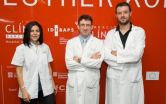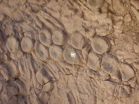(Press-News.org) The genomic analysis technologies enable the study of genetic factors related to numerous diseases. In few areas this researches brought such a big and useful volume of information as in the case of melanoma. A study published in Nature Genetics, promoted by the GenoMEL consortium, consolidates the results obtained in previous whole-genome analysis and identifies three new chromosomal regions implicated in susceptibility to melanoma. The GenoMEL consortium is funded by the European Commission and the National Institutes of Health (USA) to increase the understanding of genetic and molecular determinants of melanoma. Researchers at the Institut D'Investigacions Biomèdiques August Pi i Sunyer (IDIBAPS) and the Hospital Clínic of Barcelona have a relevant role among the promoters of this consortium led by the University of Leeds. Dr. Susana Puig leads the research team, formed by many experts as Dr. Josep Malvehy or Dr. Joan Anton Puig, and appears as an author in this Nature Genetics paper as well as in another one led from Australia. This team is supported by the CIBER of Rare Diseases (CIBERER) funded by the Spanish Ministry of Science and Innovation.
The conclusions of the European study revalidate regions and genes already identified as significant for melanoma in previous works. Thus the role of genes related to cell cycle as CDKN2A or CDK4, and other related aspects such as hair and eye pigmentation, is reinforced by the new data. The results identify too three new correlations with the risk of melanoma, located in different parts of the genome. On chromosome 2 investigators underline the role of Caspase 8, a gene related to programmed cell death or apoptosis; on chromosome 11 they localized ATM gene, linked to DNA repair, a necessary process specially after sunlight harmful effects overexposure; finally, the surprise was located on chromosome 21, where the MX2 gene was associated for the very first time with cancer and should be studied more carefully to understand its role.
The Australian work identified a large area of chromosome 1 rich with genes that might also be associated with melanoma. The relevance of these two works, both with the participation of researchers from IDIBAPS - Hospital Clínic, is reinforced by the fact that the results have been validated both in the European and Australian populations. Thus, the identified genes are relevant to the disease regardless of the population under study. Researchers face a complex puzzle, where environmental factors also play an important role. These data should aid studies aimed at designing new diagnostic and prognostic tools to make possible new treatments as well as to strengthen existing genetic counseling and diagnostic strategies.
INFORMATION:
For further information:
Institut D'Investigacions Biomèdiques August Pi i Sunyer (IDIBAPS)
IDIBAPS Communication
Àlex Argemí (aargemi@clinic.ub.es)
Tel: +34 93 227 57 00
www.idibaps.org
Genome-wide studies have identified new genes involved in susceptibility to melanoma
The results are published in 2 Nature Genetics papers involving investigators from IDIBAPS -- Hospital Clínic of Barcelona
2011-10-10
ELSE PRESS RELEASES FROM THIS DATE:
If you don't snooze, do you lose?
2011-10-10
MADISON – An ongoing lack of sleep during adolescence could lead to more than dragging, foggy teens, a University of Wisconsin-Madison study suggests.
Researchers have found that short-term sleep restriction in adolescent mice prevented the balanced growth and depletion of brain synapses, connections between nerve cells where communication occurs.
"One possible implication of our study is that if you lose too much sleep during adolescence, especially chronically, there may be lasting consequences in terms of the wiring of the brain," says Dr. Chiara Cirelli, associate ...
NYU biologists use Sinatra-named fly to show how to see the blues -- and the greens
2011-10-10
New York University biologists have identified a new mechanism for regulating color vision by studying a mutant fly named after Frank ('Ol Blue Eyes) Sinatra. Their findings, which appear in the journal Nature, focus on how the visual system functions in order to preserve the fidelity of color discrimination throughout the life of an organism. They also offer new insights into how genes controlling color detection are turned on and off.
Many biologists study how different cells develop to acquire their fate. The NYU research team, headed by Claude Desplan, a professor ...
Small molecules can starve cancer cells
2011-10-10
All cells in our body have a system that can handle cellular waste and release building blocks for recycling. The underlying mechanism is called autophagy and literally means "self-eating". Many cancer cells have increased the activity of this system and the increased release of building blocks equip the cancer cells with a growth advantage and can render them resistant towards treatment.
"We have discovered a small molecule that can block autophagy in different cancer cells and specifically, this molecule can increase the sensitivity of breast cancer cells towards one ...
Press Release Distribution Site 24-7PressRelease Achieves Milestone with 175,000 Published Press Releases
2011-10-10
24-7PressRelease.com announces today that it has reached a milestone, having distributed 175,000 press releases to date.
"The news is exciting for the company," said Michael Iwasaki, Managing Partner with 24-7PressRelease. "We continue to expand and grow in popularity with marketing, PR and communications companies looking for excellent value combined with excellent customer service. The economy is still in extreme turmoil. We are continually receiving positive feedback."
The company also offers website owners the option to add their top news ...
Drug prevents bone loss side effects of breast cancer medication
2011-10-10
A new study has found that an osteoporosis drug protects against the bone damaging side effects of certain breast cancer medications. Published early online in Cancer, a peer-reviewed journal of the American Cancer Society, the study indicates that some breast cancer patients could take zoledronic acid in addition to their anti-cancer medications to maintain bone health.
Drugs called aromatase inhibitors stop the production of estrogen in postmenopausal women and therefore make less estrogen available to stimulate the growth of certain breast cancer cells. Many postmenopausal ...
Terrestrial biodiversity recovered faster after Permo-Triassic extinction than previously believed
2011-10-10
KINGSTON, R.I. -- October 10, 2011 -- While the cause of the mass extinction that occurred between the Permian and Triassic periods is still uncertain, two University of Rhode Island researchers collected data that show that terrestrial biodiversity recovered much faster than previously thought, potentially contradicting several theories for the cause of the extinction.
David Fastovsky, URI professor of geosciences, and graduate student David Tarailo found that terrestrial biodiversity recovered in about 5 million years, compared to the 15- to 30-million year recovery ...
TCN Worldwide Announces Its Newest Member, The Bradco Companies, Serving Southern California's High Desert Regions
2011-10-10
VIH. Ross Ford, president and CEO of TCN Worldwide, is pleased to announce The Bradco Companies as the newest member to join the international real estate services organization. The Bradco Companies/TCN Worldwide is a full-service real estate firm specializing in the acquisition and disposition of raw land, commercial and industrial land projects for developers and investors as well as in the leasing and sales of commercial, industrial and office properties throughout Southern California's High Desert Regions, including Palmdale; Lancaster; Adelanto; Hesperia; Barstow; ...
Giant kraken lair discovered
2011-10-10
Boulder, CO, USA - Long before whales, the oceans of Earth were roamed by a very different kind of air-breathing leviathan. Snaggle-toothed ichthyosaurs larger than school buses swam at the top of the Triassic Period ocean food chain, or so it seemed before Mount Holyoke College paleontologist Mark McMenamin took a look at some of their remains in Nevada. Now he thinks there was an even larger and more cunning sea monster that preyed on ichthyosaurs: a kraken of such mythological proportions it would have sent Captain Nemo running for dry land. McMenamin will be presenting ...
Critical minerals ignite geopolitical storm
2011-10-10
The clean energy economy of the future hinges on a lot of things, chief among them the availability of the scores of rare earth elements and other elements used to make everything from photovoltaic panels and cellphone displays to the permanent magnets in cutting edge new wind generators. And right out of the gate trouble is brewing over projected growth in demand for these minerals and the security of their supplies.
Last year, for instance, China restricted the export of neodymium, which is used in wind energy generators. The move was ostensibly to direct the supplies ...
Handlink Grows its North American Sales Channel with Newegg.com
2011-10-06
Handlink Technologies Inc., the guestWiFi account generator and WiFi subscriber gateway vendor has today announced the appointment as Newegg marketplace seller in North American region. Handlink is a leading company in providing commercially advanced and innovative WiFi hotspot authentication and billing solutions to the Small Office and Home Office (SOHO), Enterprise, Small and Medium Business (SMB), Hotel, Hospitality, Government and Education markets.
"We are very delighted that we can list our products for sales on the Newegg.com in the US" said David ...
LAST 30 PRESS RELEASES:
Making lighter work of calculating fluid and heat flow
Normalizing blood sugar can halve heart attack risk
Lowering blood sugar cuts heart attack risk in people with prediabetes
Study links genetic variants to risk of blinding eye disease in premature infants
Non-opioid ‘pain sponge’ therapy halts cartilage degeneration and relieves chronic pain
AI can pick up cultural values by mimicking how kids learn
China’s ecological redlines offer fast track to 30 x 30 global conservation goal
Invisible indoor threats: emerging household contaminants and their growing risks to human health
Adding antibody treatment to chemo boosts outcomes for children with rare cancer
Germline pathogenic variants among women without a history of breast cancer
Tanning beds triple melanoma risk, potentially causing broad DNA damage
Unique bond identified as key to viral infection speed
Indoor tanning makes youthful skin much older on a genetic level
Mouse model sheds new light on the causes and potential solutions to human GI problems linked to muscular dystrophy
The Journal of Nuclear Medicine ahead-of-print tip sheet: December 12, 2025
Smarter tools for peering into the microscopic world
Applications open for funding to conduct research in the Kinsey Institute archives
Global measure underestimates the severity of food insecurity
Child survivors of critical illness are missing out on timely follow up care
Risk-based vs annual breast cancer screening / the WISDOM randomized clinical trial
University of Toronto launches Electric Vehicle Innovation Ontario to accelerate advanced EV technologies and build Canada’s innovation advantage
Early relapse predicts poor outcomes in aggressive blood cancer
American College of Lifestyle Medicine applauds two CMS models aligned with lifestyle medicine practice and reimbursement
Clinical trial finds cannabis use not a barrier to quitting nicotine vaping
Supplemental nutrition assistance program policies and food insecurity
Switching immune cells to “night mode” could limit damage after a heart attack, study suggests
URI-based Global RIghts Project report spotlights continued troubling trends in worldwide inhumane treatment
Neutrophils are less aggressive at night, explaining why nighttime heart attacks cause less damage than daytime events
Menopausal hormone therapy may not pose breast cancer risk for women with BRCA mutations
Mobile health tool may improve quality of life for adolescent and young adult breast cancer survivors
[Press-News.org] Genome-wide studies have identified new genes involved in susceptibility to melanomaThe results are published in 2 Nature Genetics papers involving investigators from IDIBAPS -- Hospital Clínic of Barcelona


